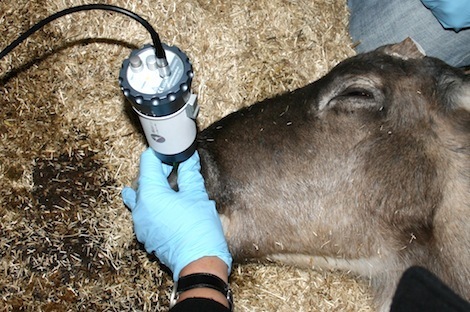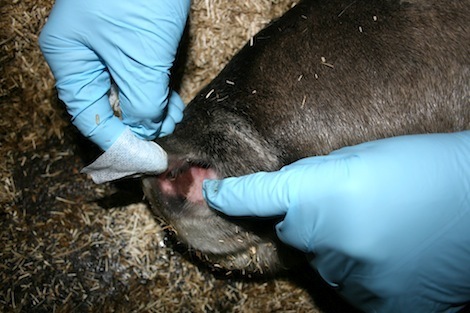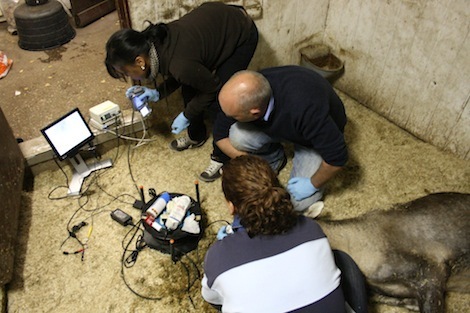Marc Abrahams's Blog, page 527
December 21, 2012
End of the World (or not)
The World has recently ended. So you won’t be reading this.
Scenario [2]
The End of the World has been greatly exaggerated.
Thus you still have the opportunity to consider : ‘Corporeal remains : vulnerability, proximity and living-on after the end of the world’ Environment and planning A., 40 (2), 2008, pp. 423-445. Where Dr. Paul Harrison of the Dept. of Geography at Durham University, UK, offers a sustained reflection on the nature of corporeal vulnerability as an inherent and noneliminable aspect of corporeal existence.
“Drawing on the writing of Emmanuel Levinas and reflecting on experiences of corporeal expropriation such as insomnia and exhaustion, I suggest how we may begin to think sensibility and the sensuous beyond their almost exclusive interpretation in terms of comprehension, purpose, or intention while retaining the irreducibility of corporeal life to a matter of social construction or contextual epiphenomenon.”
BONUS: The 2011 Ig Nobel Prize in mathematics was awarded to Dorothy Martin of the USA (who predicted the world would end in 1954),Pat Robertson of the USA (who predicted the world would end in 1982), Elizabeth Clare Prophet of the USA (who predicted the world would end in 1990), Lee Jang Rim of KOREA (who predicted the world would end in 1992), Credonia Mwerinde of UGANDA (who predicted the world would end in 1999), and Harold Camping of the USA (who predicted the world would end on September 6, 1994 and later predicted that the world will end on October 21, 2011), for teaching the world to be careful when making mathematical assumptions and calculations.

December 20, 2012
Mouthfeel Attributes of Liquid Foods by a Posthumus Funnel
This may be the most significant scientific paper of the past two years that concerns the Posthumus Funnel:
“Improvement of the Prediction of Mouthfeel Attributes of Liquid Foods by a Posthumus Funnel,” Alexander Kutter, Jaswinder Pal Singh, Cornelia Rauh and Antonio Delgado, Journal of Texture Studies, vol. 42 (2011) 217–227.

The simulator that keeps on giving
The BBC reports:
“‘Vomiting Larry’ is busy being sick over and over again in an experiment to test just how far the winter vomiting bug can travel when it makes you ill. Lucky for Larry, he is not a constantly retching human – but a simulated vomiting system that shows the virus can travel an impressive 3m (9.8ft) in a projectile episode, according to his creators at the Health and Safety Laboratory.”
(Thanks to investigator Tony Tweedale for bringing this to our attention.)
BONUS: A bit more detail about Larry and the lab.

December 19, 2012
Bagels, and how to slice them
A calculating look at the end of the world
Some persons predict that the world will end on December 21, 2012. Perhaps they are correct. For mathematical context, take a look back (perhaps the last look back any of us will have a chance to make!) at the 2011 Ig Nobel Prize winners in the field of mathematics:
MATHEMATICS PRIZE: Dorothy Martin of the USA (who predicted the world would end in 1954), Pat Robertson of the USA (who predicted the world would end in 1982), Elizabeth Clare Prophet of the USA (who predicted the world would end in 1990), Lee Jang Rim of KOREA (who predicted the world would end in 1992), Credonia Mwerinde of UGANDA (who predicted the world would end in 1999), and Harold Camping of the USA (who predicted the world would end on September 6, 1994 and later predicted that the world will end on October 21, 2011), for teaching the world to be careful when making mathematical assumptions and calculations.
BONUS: Dorothy Martin was the key figure in the formation of the psychological concept of “cognitive dissonance,” the formation of which itself involved some impressive psychological oddities.
BONUS (only peripherally related, if at all): The Halting Problem, and “How Dr. Seuss would prove the halting problem undecidable” (details of the latter)

December 18, 2012
Much ado ablaut flim flam
 Flim flam gets a wordy going over from Professor Steen Schousboe, of the Department of English, Germanic and Romance Studies at the University of Copenhagen. His article, entitled “Linguistic flim-flam?” gets down to the nitty gritty of linguistic ‘Reduplication’ – and it’s pell mell chock a block with super duper, hunky dory reduplicative chit chat. There’s no hint of mumbo jumbo or hocus pocus, and it’s certainly not hoity toity, arty farty, wishy washy, or higgledy-piggledy. If there is one eency-weency itsy bitsy niggle-ette it would be that there could be more examples. Where are lubbly jubbly [1], funny money [2], or wimple pimple [3]? In short though, it’s super duper, tip top and ship shape. Quite the bees knees. Okey dokey? See: ‘ Linguistic flim-flam? ‘ British and American Studies , vol 14, pp. 275-281. (scroll to page 275 in the .pdf)
Flim flam gets a wordy going over from Professor Steen Schousboe, of the Department of English, Germanic and Romance Studies at the University of Copenhagen. His article, entitled “Linguistic flim-flam?” gets down to the nitty gritty of linguistic ‘Reduplication’ – and it’s pell mell chock a block with super duper, hunky dory reduplicative chit chat. There’s no hint of mumbo jumbo or hocus pocus, and it’s certainly not hoity toity, arty farty, wishy washy, or higgledy-piggledy. If there is one eency-weency itsy bitsy niggle-ette it would be that there could be more examples. Where are lubbly jubbly [1], funny money [2], or wimple pimple [3]? In short though, it’s super duper, tip top and ship shape. Quite the bees knees. Okey dokey? See: ‘ Linguistic flim-flam? ‘ British and American Studies , vol 14, pp. 275-281. (scroll to page 275 in the .pdf)
Notes :
[1] pleasantly satisfactory
[2] quantative easing
[3] contact dermatitis experienced by nuns.
‘Ablaut’ definition
BONUS: Some Word Ways

The eagle and child — a new case and a famous old one
This video — of an eagle trying to snatch a child in Montreal — echoes the once-famous case of “the Taung Child”. The historic case was discussed in the study ”The Load of the Taung Child,” Lee R. Berger and Ronald J. Clarke, Nature, vol. 379, no. 29, 1996, p. 778. We held a limerick contest in 2003, inviting people to summarize the article. Those limericks are reprinted below.
Here are the limericks about “The Load of the Taung Child”:
INVESTIGATOR BEN MATTHEWS:
An African species of raptor
To the Taung child said, "I'll be your captor
In small pieces you'd best
Come away to my nest."
And that's how the raptor kidnapped her.
INVESTIGATOR GRAHAM LESTER:
Quipped the eagle, "What fun it is when you
Notice that this poor child's change of venue
Marked the first human flight --
And to doubly delight:
It's our first night with man in the menu"
INVESTIGATOR LESLIE ROSENBLOOD:
The question is whether it's legal
For a raptor (perhaps a crowned eagle?)
To collect as a toll
A child who is whole
Or in pieces the size of a sea gull.
INVESTIGATOR WILLIAM SMITH:
Hedenstrom's on the right track
In giving this theory a whack.
No -- no single, large eagle,
(No matter how regal)
Could carry out such an attack.
INVESTIGATOR MEL DICKSON:
Hedenstrom says we are wrong:
A crowned eagle is not all that strong.
We suggest that a mate
helped distribute the weight
To carry off poor kiddy Taung.
(Thanks to investigator Bill Taylor for bringing the video to our attention.)
BONUS: ”Further evidence for eagle predation of, and feeding damage on, the Taung child,” L.R. Berger and W.S. McGraw, South African Journal of Science, 103, November/December 2007.
BONUS (unrelated): The Eagle and Child pub in Oxford, England.

An apparently startling discovery: Young persons send text messages
The Pew Research Center announced — in large, bold type — their apparently surprising new research finding:
Texting Is Nearly Universal Among Young Adult Cell Phone OwnersThe vast majority of cell phone owners send and receive text messages. Large numbers of cell owners across all demographic groups do so, with the exception of mobile phone owners 65 and older, according to a Pew Internet & American Life Project survey conducted in August and September.
Texting is most prevalent among cell owners ages 18 to 29 — 97% of them use their cell phones to send texts….
(Thanks to investigator Rose Fox for bringing this to our attention.)

Physiology: Why Rudolph’s Nose is Red
A new Dutch study explains the likely physiology of Rudolph the reindeer’s red nose:
“Microcirculatory investigations of nasal mucosa in reindeer Rangifer tarandus (Mammalia, Artiodactyla, Cervidae): Rudolph’s nose was overheated,” Ben van der Hoven, Eva Klijn, Michel van Genderen, Willem Schaftenaar, Lisette L. de Vogel, Ditty van Duijn and Erwin J.O. Kompanje (a member of the Improbable Research editorial board), Deinsea, December 19, 2012, pp. 37-46. The authors, at several institutions in Rotterdam, The Netherlands, report:
“The classic Christmas tale and song ‘Rudolph the red-nosed reindeer’ evoked several theories about the cause of the remarkable colour of the animal’s nose, ranging from (1) a common cold, (2) alcoholic intoxication, to (3) a parasitic infection of the nostrils. Still, there is no conclusive scientific evidence of the nature of Rudolph’s red nose. We found a clue in earlier studies that showed reindeer are able to restrict respiratory heat loss by the use of nasal heat exchange. Work that demonstrated a vascular basis for regulation of nasal heat exchange through capillaries and arterio-venous anastomoses inspired us to use Sidestream Dark-Field (SDF) imaging to examine the microvascular flow in the nasal mucosa of Zoo-kept reindeer (Rangifer tarandus fennicus). We found hairpin shaped ‘radiator-like’ (looping) small blood vessels in the nasal mucosa, which are most likely responsible for the warming and/or cooling of the inhaled freezing arctic air during nasal panting. This led to the following new explanation of the nature of Rudolph’s red nose. The exceptional physical burden of flying with a sleigh with Santa Claus as a heavy load could have caused cerebral and bodily hyperthermia, resulting in an overworked nasal cooling mechanism that resembles an overheated cooling radiator in a car: Rudolph suffered from hyperemia of the nasal mucosa (a red nose) under more extreme heat loads during flight with a sleigh.”


BONUS: Colleagues of these researchers published a study of their own, on the same day, in the BMJ:
“Why Rudolph’s nose is red: observational study,” Can Ince, Anne-Marije van Kuijen, Dan M J Milstein, Koray Yürük, Lars P Folkow, Wytske J Fokkens, Arnoldus S Blix, BMJ, December 17, 2012;345:e8311.
BONUS: Investigator Kompanje supplies background info.
BONUS: Performances of the song “Rudolph the Red Nosed Reindeer”:

December 17, 2012
Wordplay proves a fruitful area for research
Words, words, words are the bread, butter, salt, pepper, meat and potatoes of a small, US-based magazine called Word Ways that has been coming out four times a year since 1968. Dmitri Borgmann, the founding editor, described it as “the journal of recreational linguistics”. Its essence, in a word: wordplay.
Borgmann’s obituary, in a 1985 issue of Word Ways, says his greatest achievement was to “demonstrate that wordplay is an intellectual discipline in its own right”. Borgmann’s reputation was already such, says the obituary, that Standard Oil of New Jersey had hired him to devise a replacement for its antiquated brand name. ‘Twas Borgmann, they say, who spiffed and twisted old-fashioned “Esso” into modern “Exxon”. (Later issues of Word Ways say that the Esso-into-Exxon story may be rather more complicated.)
The first issue of Word Ways included Borgmann’s The Longest Word in English, in which he traipses along the length of “the 27-letter honorjficajhlitudinitatibus”, “the 28-letter antidisestablishmentarianism”…
So begins this week’s Improbable Research column in The Guardian.

Marc Abrahams's Blog
- Marc Abrahams's profile
- 14 followers








